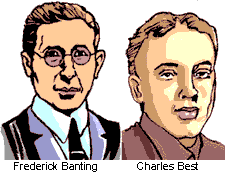
Dimdima
Online Children's Magazine from India

Dimdima
Online Children's Magazine from India

In 1920, Canadian surgeon Frederick Banting visited the University of Toronto to speak to John J.R. Macleod, the newly appointed head of the department of physiology. Banting had a new idea on how to find not only the cause but also treat the so-called "sugar disease" or diabetes.
In diabetes, the blood of patients contains more sugar than normal. A substance called insulin is absent or present only in small quantities in these patients. It is this insulin which removes the sugar from the blood and sends them into various cells of the body.
It was late in the nineteenth century that , scientists realized that there was a connection between the pancreas and diabetes.
Banting and his assistant Charles Best extracted a substance called insulin from the pancreas of diabetic dogs. A 14-year-old boy dying of diabetes was injected with this substance. The injection indeed lowered his blood sugar and other signs of the disease. Banting and Best published the first paper on their discovery a month later, in February, 1922. In 1923, the Nobel Prize was awarded to Banting and Macleod for the discovery, and each shared their portion of the prize money with the other researchers on the project.
The discovery of insulin was one of the most revolutionary moments in medicine. Though it took some time to work out proper dosages and to develop manufacturing processes to make enough insulin of consistent strength and purity, the introduction of insulin seemed literally like a miracle. One year the disease was an automatic death sentence; the next, people -- even children -- had hopes of living full and productive lives even with the disease.
EXPLORE MORE...
Get Help or Give Help.
- Do you have a Science Question?
- Post it here and get the answer.
- Some questions posted by others are not yet answered.
- View those questions and answer them.
Dimdima is the Sanskrit word for ‘drumbeat’. In olden days, victory in battle was heralded by the beat of drums or any important news to be conveyed to the people used to be accompanied with drumbeats.
Bharatiya Vidya Bhavan
K. M Munshi Marg,
Chowpatty, Mumbai - 400 007
email : editor@dimdima.com
Bharatiya Vidya Bhavan
505, Sane Guruji Marg,
Tardeo, Mumbai - 400 034
email : promo@dimdima.com
Dimdima.com, the Children's Website of Bharatiya Vidya Bhavan launched in 2000 and came out with a Printed version of Dimdima Magazine in 2004. At present the Printed Version have more than 35,000 subscribers from India and Abroad.